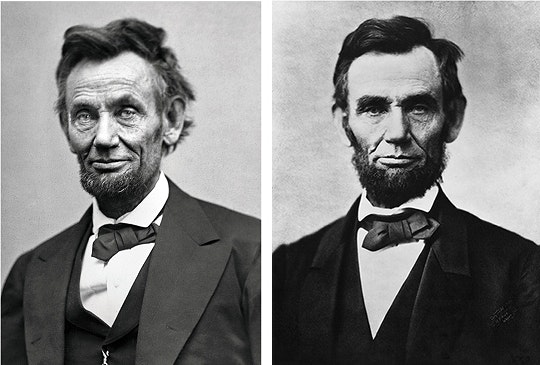
The Serious and the Smirk The Smile in Portraiture
Why do we so seldom see people smiling in painted portraits? Nicholas Jeeves explores the history of the smile through the ages of portraiture, from Da Vinci's Mona Lisa to Alexander Gardner's photographs of Abraham Lincoln.
September 18, 2013
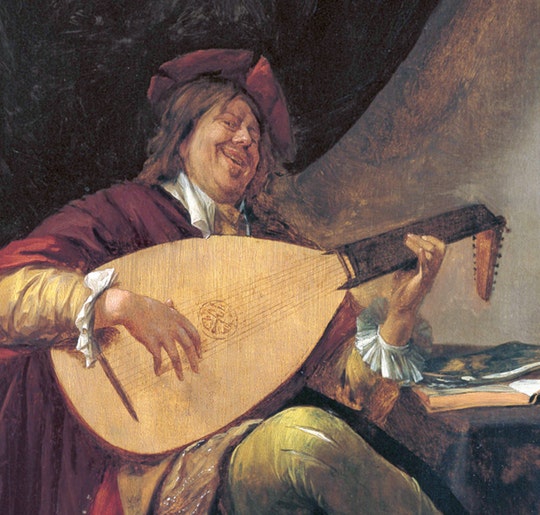 Scroll through the whole page to download all images before printing.
Scroll through the whole page to download all images before printing.Jan Steen, Self Portrait, 3rd quarter of 17th century — Source.
Today when someone points a camera at us, we smile. This is the cultural and social reflex of our time, and such are our expectations of a picture portrait. But in the long history of portraiture the open smile has been largely, as it were, frowned upon.
In Charles Dickens’ Nicholas Nickleby (1838-39) the portrait painter Miss La Creevy ponders the problem:
. . . People are so dissatisfied and unreasonable, that, nine times out of ten, there’s no pleasure in painting them. Sometimes they say, “Oh, how very serious you have made me look, Miss La Creevy!” and at others, “La, Miss La Creevy, how very smirking!”. . . In fact, there are only two styles of portrait painting; the serious and the smirk; and we always use the serious for professional people (except actors sometimes), and the smirk for private ladies and gentlemen who don’t care so much about looking clever.
A walk around any art gallery will reveal that the image of the open smile has, for a very long time, been deeply unfashionable. Miss La Creevy’s equivocal ‘smirks’ do however make more frequent appearances: a smirk may offer artists an opportunity for ambiguity that the open smile cannot. Such a subtle and complex facial expression may convey almost anything — piqued interest, condescension, flirtation, wistfulness, boredom, discomfort, contentment, or mild embarrassment. This equivocation allows the artist to offer us a lasting emotional engagement with the image. An open smile, however, is unequivocal, a signal moment of unselfconsciousness.
Such is the field upon which the mouth in portraiture has been debated: an ongoing conflict between the serious and the smirk. The most famous and enduring portrait in the world functions around this very conflict. Millions of words have been devoted to the Mona Lisa and her smirk — more generously known as her ‘enigmatic smile’ — and so today it’s difficult to write about her without sensing that you’re at the back of a very long and noisy queue that stretches all the way back to 16th century Florence. But to write about the smile in portraiture without mentioning her is perverse, for the effect of the Mona Lisa has always been in its inherent ability to demand further examination. Leonardo impels us to do this using a combination of skilful sfumato (the effect of blurriness, or smokiness) and his profound understanding of human desire. It is a kind of magic: when you first glimpse her, she appears to be issuing a wanton invitation, so alive is the smile. But when you look again, and the sfumato clears in focus, she seems to have changed her mind about you. This is interactive stuff, and paradoxical: the effect of the painting only occurs in dialogue, yet she is only really there when you’re not really looking. The Mona Lisa is thus, in many ways, designed to frustrate — and frustrate she did.
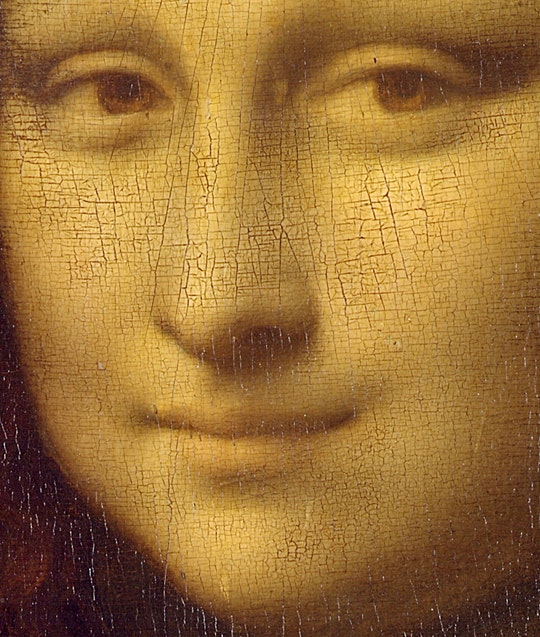 Scroll through the whole page to download all images before printing.
Scroll through the whole page to download all images before printing.Detail from Leonardo da Vinci’s La Gioconda (Mona Lisa), 1503–1506 — Source.
The hubbub around her smile really got going in the 19th century, when unfettered critical devotion to Renaissance art was at an all-time high. One critic and historian in particular, Jules Michelet, enjoyed, or at least endured, a very personal moment with her. In Volume VII of his Histoire de France (1855) he wrote, ‘This canvas attracts me, calls me, invades me. I go to it in spite of myself, like the bird to the serpent.’ Artfully concealed under the guise of Romantic criticism, this was in fact an expression of the new cult of the Mona Lisa, and over the years historians would attempt to outdo each other with their devotion to her charms. Michelet’s son-in-law Alfred Dumesnil, also a critic, went even further in his L’art Italien, as if locking antlers with his in-law: ‘The smile is full of attraction, but it is the treacherous attraction of a sick soul that renders sickness. This so soft a look, but avid like the sea, devours.’ In England, John Ruskin asserted that it was a merely a ‘caricature’, to which a young Oxford don named Walter Pater responded in his Renaissance: ‘All the thoughts and experience of the world have etched and moulded there. . . the animalism of Greece, the lust of Rome, the mysticism of the middle age with its spiritual ambition and imaginative loves, the return of the Pagan world, the sins of the Borgias. . .’
Things came to a head in 1919 when the French artist Marcel Duchamp triumphantly created his version, augmenting the smile with a fancy moustache and titling it L.H.O.O.Q., which only exacerbated things in rascally Dadaist fashion. (L.H.O.O.Q. translates phonetically as ‘she has a hot arse’, but also relates to an idiomatic expression of ‘fire down below’.) For Jules Michelet she may have been the object of romantic love: for Duchamp, she was the object of spirited masturbation.
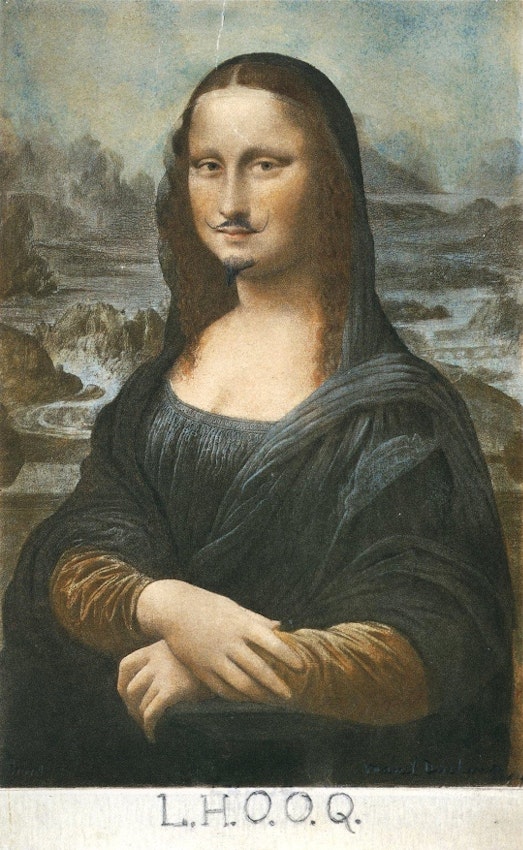 Scroll through the whole page to download all images before printing.
Scroll through the whole page to download all images before printing.Marcel Duchamp’s L.H.O.O.Q. (1919) — Source (NB. Only public domain in the U.S.)
It remains a commonly held belief that for hundreds of years people didn’t smile in pictures because their teeth were generally awful. This is not really true — bad teeth were so common that this was not seen as necessarily taking away from someone’s attractiveness. Lord Palmerston, Queen Victoria’s whig prime minister, was often described as being devastatingly good-looking, and having a ‘strikingly handsome face and figure’ despite the fact that he had a number of prominent teeth missing as a result of hunting accidents. It was only in later life, when he acquired a set of flapping false teeth, that his image was compromised. His fear of them falling out when he spoke led to a stop-start delivery of his speeches, causing Disraeli to openly poke fun at him in parliament.
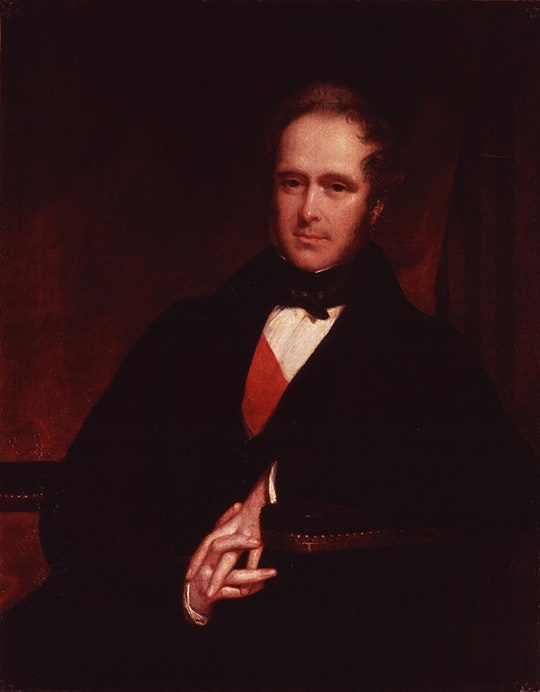 Scroll through the whole page to download all images before printing.
Scroll through the whole page to download all images before printing.John Partridge’s portrait of Henry John Temple, 3rd Viscount Palmerston (1844-5) — Source.
Nonetheless, both painters and sitters did have a number of good reasons for being disinclined to encourage the smile. The primary reason is as obvious as it is overlooked: it is hard to do. In the few examples we have of broad smiles in formal portraiture, the effect is often not particularly pleasing, and this is something we can easily experience today. When a camera is produced and we are asked to smile, we perform gamely. But should the process take too long, it takes only a fraction of a moment for our smiles to turn into uncomfortable grimaces. What was voluntary a moment ago immediately becomes intolerable. A smile is like a blush — it is a response, not an expression per se, and so it can neither be easily maintained nor easily recorded.
Smiling also has a large number of discrete cultural and historical significances, few of them in line with our modern perceptions of it being a physical signal of warmth, enjoyment, or indeed of happiness. By the 17th century in Europe it was a well-established fact that the only people who smiled broadly, in life and in art, were the poor, the lewd, the drunk, the innocent, and the entertainment — some of whom we’ll visit later. Showing the teeth was for the upper classes a more-or-less formal breach of etiquette. St. Jean-Baptiste De La Salle, in The Rules of Christian Decorum and Civility of 1703, wrote:
There are some people who raise their upper lip so high. . . that their teeth are almost entirely visible. This is entirely contradictory to decorum, which forbids you to allow your teeth to be uncovered, since nature gave us lips to conceal them.
Thus the critical point: should a painter have persuaded his sitter to smile, and chosen to paint it, it would immediately radicalise the portrait, precisely because it was so unusual and so undesirable. Suddenly the picture would be ‘about’ the open smile, and this is almost never what an artist, or a paying subject, wanted.
In this sense, a portrait was never so much a record of a person, but a formalised ideal. The ambition was not to capture a moment, but a moral certainty. Politicians were particularly sensitive to this. For a more modern, photographic example of the principle, we may consider Abraham Lincoln. Here was a man better known than most, in his day, for his sense of humour, there being a number of well-known stories about him regularly drawing hoots of laughter from those in his company. While there are some informal images of him looking distinctly avuncular, a wit doesn’t abolish slavery without tough critical opposition, and in his best-known image, the ‘Gettysburg portrait’, he takes on the gravest expression imaginable. So powerful are these images that this is how he is generally remembered today. Mark Twain, a contemporary of Lincoln’s, was firm on the matter in a a letter to the Sacramento Daily Union:
A photograph is a most important document, and there is nothing more damning to go down to posterity than a silly, foolish smile caught and fixed forever.
As far back as the late 1460s, Sicily’s Antonello da Messina was surely considering all this when he painted what we now know as Portrait of a Man (one of many Antonello portraits of unknown sitters). Antonello painted quite a few portraits with smiles, and the subject seemed to interest him. We might even infer that it was the very challenge of painting a smile in a new tradition that motivated him, being a pioneer by nature. As you might expect from any portrait of the period, there is little doubt that the sitter is a gentleman. Antonello doesn’t go quite so far as to show the teeth, but does goes give him long dimples on his cheeks and laughter lines at the corners of his eyes. The teeth, we feel, are but a moment away. Unfortunately, this has the effect of making him look less, rather than more, human. The tension between the static nature of painting and the awkward animation of the smile confuses us, so much so that we find a facial expression that is unnervingly unreadable. It is ugly in a way that is hard to describe — it is just repulsively ‘other’ — though some people still think it beautiful, and the unknown Man himself must at least have been satisfied.
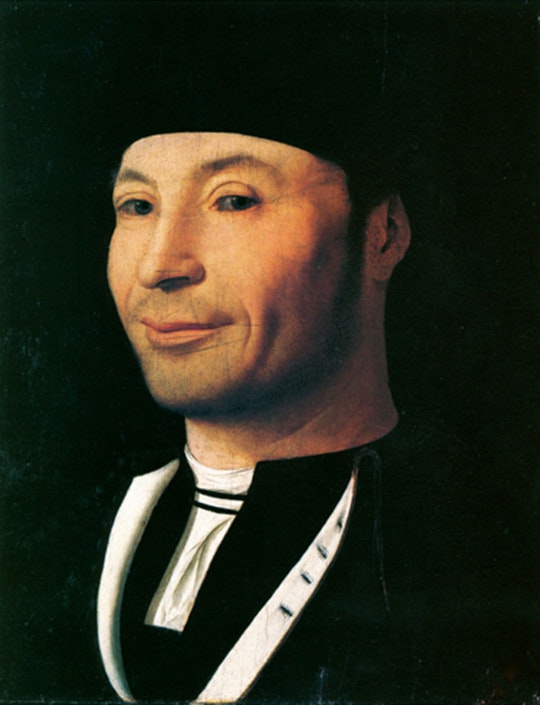 Scroll through the whole page to download all images before printing.
Scroll through the whole page to download all images before printing.Antonello da Messina’s Portrait of a Man (ca.1475) — Source.
Better-known artists also attempted it. Caravaggio’s Triumphant Eros of 1602 was designed as a meditation on adolescent beauty, and as such is not strictly portraiture. But so wild and voracious was the boy’s smile that it was typically read at the time as a celebration of tumescent homosexual passion. In the picture, all the instruments of civilised society have been turned over in the face of all-consuming love — but his wicked smile speaks of lust. It may seem extraordinary to us today, in these unforgiving times, that the open smile was perceived as being the most pointedly shocking aspect of the picture despite Eros’ childishly displayed sex. Caravaggio, a rebel and sociopath to his core, revelled in the scandal.
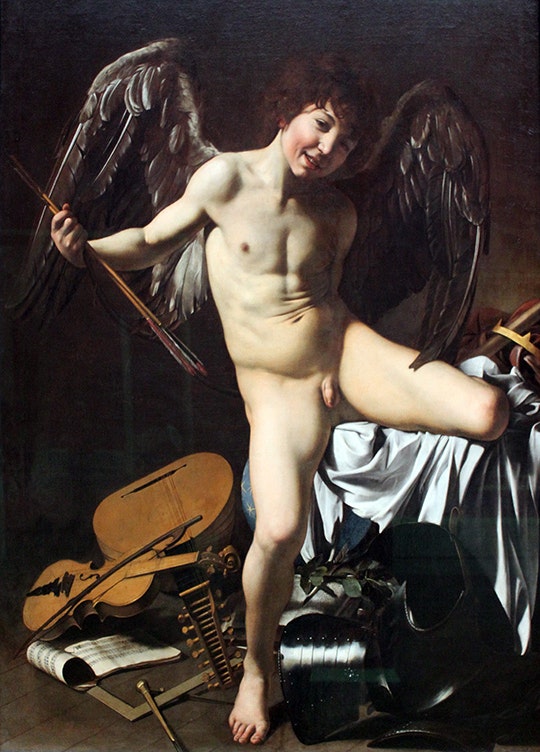 Scroll through the whole page to download all images before printing.
Scroll through the whole page to download all images before printing.Caravaggio’s Triumphant Eros (1602-3) — Source.
In more modern times, John Singer Sargent, in his 1890 study for Miss Eleanor Brooks, draws his subject with a smile that manages to be both truly warm and civilised. Despite this, he later dropped it in favour of a more composed expression in the final work, clearly dissatisfied with the result. As he himself put it, ‘A portrait is a picture of a person with something wrong with the mouth.’ Again, we need to speculate a little as to what might have gone through his mind, but such a choice would lead us to believe that even a painter of his capability found it hard, in the end, to reconcile the smile with his reputation.
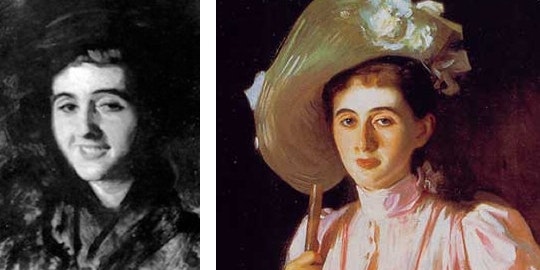 Scroll through the whole page to download all images before printing.
Scroll through the whole page to download all images before printing.Left: John Singer Sargent’s study for Miss Eleanor Brooks (1890) — Source. Right: Detail from the finished painting (1890) — Source.
These artists from very different centuries have all grappled with the open smile, but each of them has failed to inspire in the viewer a consistent reading. It seems that, paradoxically, the less readable the smile, the more we feel we are able to read into it. As with magic tricks, we seem to be moved more by wonder than with explanation.
To see the smile at its biggest and best, we have to leave the upper classes and instead visit our attentions on those lower in the social order. 17th century Dutch painters were fascinated with recording the fullness of life, and deliberately sought out the smiles found within it. Here there are almost no end of artists to choose from, and in consequence ‘Dutchness’ in painting, and in life, was often a society shorthand for licentiousness. Jan Steen, Franz Hals, and Judith Leyster were all followers of this style, all painted broad smiles, and all were said to be good company, there being no attempt at separation between the artist, the viewer, and the subject. With the artists as complicit as they were explicit, it was a mutual love affair that put them firmly at the centre of contemporary life.
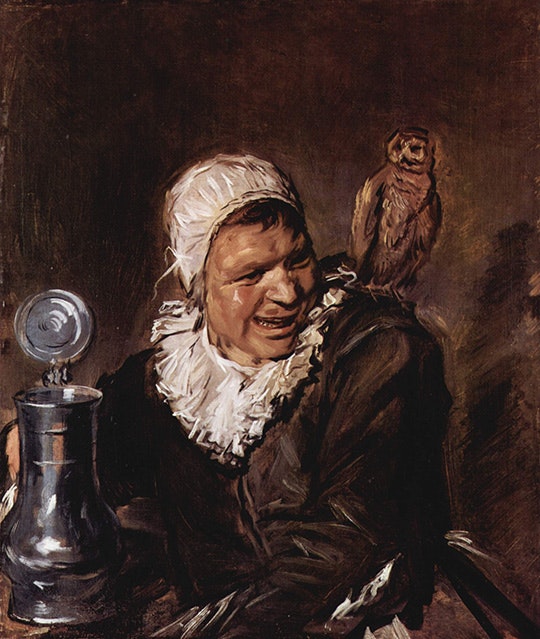 Scroll through the whole page to download all images before printing.
Scroll through the whole page to download all images before printing.Franz Hals’ Malle Babbe (1633–1635) — Source.
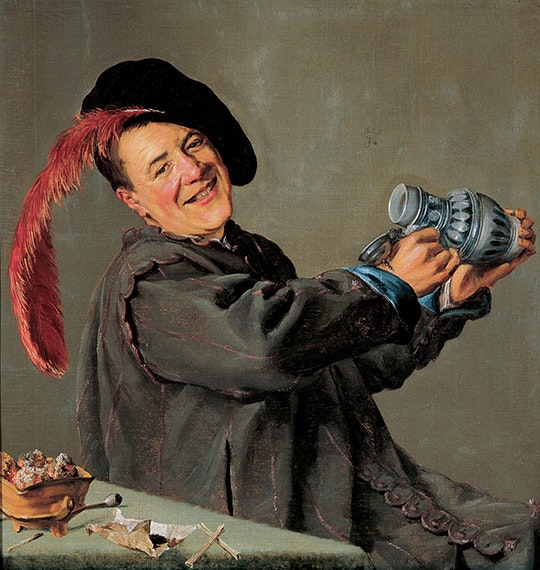 Scroll through the whole page to download all images before printing.
Scroll through the whole page to download all images before printing.Judith Leyster’s Jolly Toper (1629) — Source.
Possibly the most accomplished of these is Gerrit van Honthorst. Having seen Caravaggio’s work in Italy, van Honthorst was so taken with him that he made every effort to channel his style, particularly with his mastery of chiaroscuro. But it was not an obvious choice to make. Caravaggio was a contentious figure — infamous during his own lifetime, he was virtually forgotten on his death. (It was only in the early 20th century that his influence on painting was fully appreciated — at which point he was either celebrated as the father of modern painting, or denounced as its murderer.) But van Honthorst was in love. He immediately saw in Caravaggio something real and worthwhile, and sped back to Utrecht to record his own amplified scenes of late-night eating, drinking and music-making in rich detail.
A terrific example of the life and low-life that he sought to represent is The Laughing Violinist of 1624. Since the Renaissance, any reference to music in painting was usually interpreted as a symbol of love. Van Honthorst, again inspired by Caravaggio, wanted to go much further, with sexual overtones so explicit as to break new ground. And so his laughing violinist not only has a lewd expression and almost audible laugh, but is making a universally understood hand gesture. What is quite brilliant about the painting is that, on its own, it crashes through the boundaries of contemporary taste with sheer skill (just as Caravaggio’s paintings did). But when it is hung, as intended, immediately to the right of his portrait Girl Counting Money, it becomes clear who the jeer is aimed at. It is an explicit dialogue, just as Leonardo made with the Mona Lisa, but without the pretence of subtlety. Van Honthorst cracks the issue of the open smile by ensuring that we see it as it exists — not as an expression, but as a reaction.
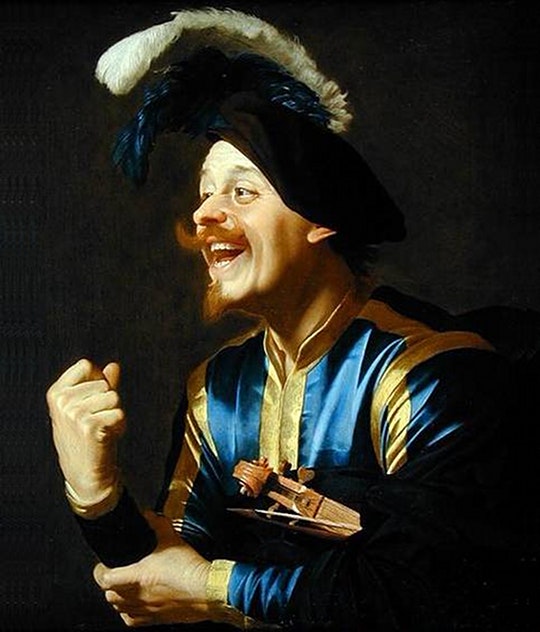 Scroll through the whole page to download all images before printing.
Scroll through the whole page to download all images before printing.Gerrit van Honthorst’s The Laughing Violinist (1624) — Source.
The Dutch, likely relieved to see the back of the strict Calvinist regime of the 16th century, celebrated their everyday lives and experiences with art that was made to be inclusive. Such a relaxed attitude never really caught on in countries where a more protective attitude to class prevailed. England’s William Hogarth was very interested in the smile and its impact on beauty. In his Analysis of Beauty he approved of the lines that ‘form a pleasing smile about the corners of the mouth,’ but loathed a face in extreme contour, considering it ‘a silly or disagreeable look,’ so he saved it for the poor, the corrupt, the drunk, but without the affection of his Dutch near-contemporaries.
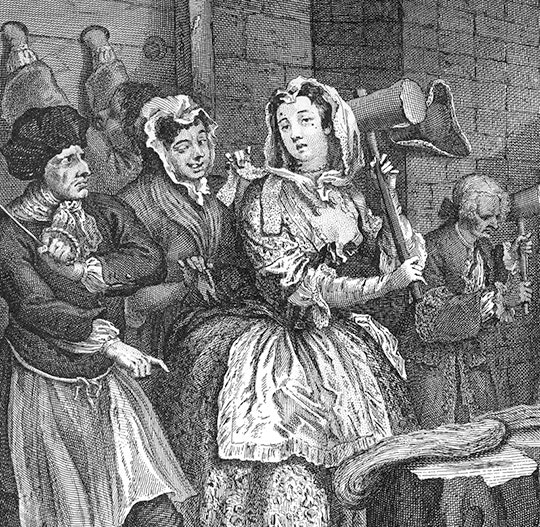 Scroll through the whole page to download all images before printing.
Scroll through the whole page to download all images before printing.William Hogarth’s A Harlot’s Progress, Plate 4 (1732) — Source.
By 1877 the photographic pioneer Eadweard Muybridge had solved the problem of fleeting movement with his series of photographs entitled The Horse In Motion. As we know from artists’ previous attempts to paint running horses, the horse’s movement was impossible to capture accurately in paint. Thanks to Muybridge’s pictures, almost overnight all the painted horses became transformed from awkward caricature into great galloping beasts. And before you could say ‘cheese’ photographers found themselves able to capture another fleeting thing: the true smile.
Nowadays each of us is recorded across hundreds, or thousands of images, and many of us are smiling broadly. Collected, they represent us accurately in all our moods and modes, so we no longer have to worry about being defined by one picture. Indeed, unlike Abraham Lincoln, modern US presidents try to ensure that a number of images are available that will capture the gamut of their emotional range, from troubled solemnity to enthusiastic joy. The same goes for the royal families, recorded in either carefree, knockabout moments, or in stately focus. In the 21st century these figures must be all things to all people, and all occasions.
Nicholas Jeeves is a designer, writer, and lecturer at Cambridge School of Art. He is also designer and editor of Lucian's Dialogues of the Gods, a new edition of Lucian's comic masterpiece out now on PDR Press.





